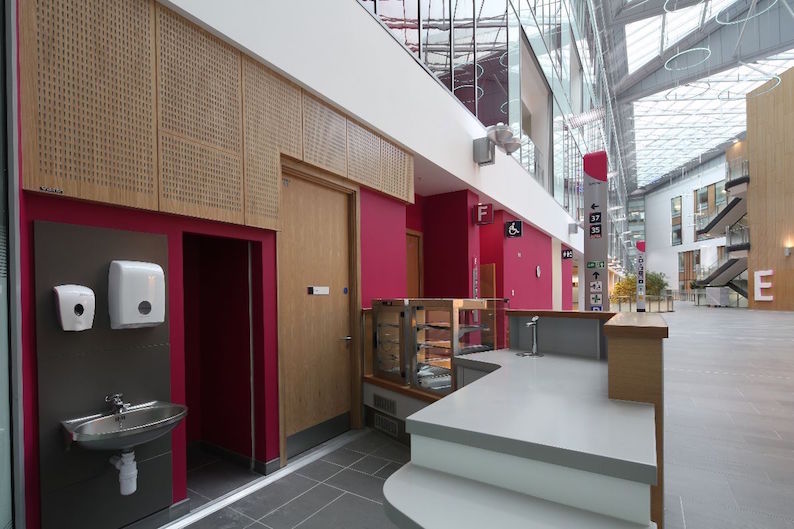 Cleanzine: your weekly cleaning and hygiene industry newsletter 3rd July 2025 Issue no. 1169
Cleanzine: your weekly cleaning and hygiene industry newsletter 3rd July 2025 Issue no. 1169
Your industry news - first
The original and best - for over 20 years!
We strongly recommend viewing Cleanzine full size in your web browser. Click our masthead above to visit our website version.
The current state of healthcare hygiene
 Hospitals and other healthcare centres contain those who are most vulnerable to disease as well as high concentrations of patients with infectious conditions. Therefore, it is essential that no corners are cut when it comes to hygiene - if procedures are not carried out properly, it could have catastrophic effects on patients in vulnerable states.
Hospitals and other healthcare centres contain those who are most vulnerable to disease as well as high concentrations of patients with infectious conditions. Therefore, it is essential that no corners are cut when it comes to hygiene - if procedures are not carried out properly, it could have catastrophic effects on patients in vulnerable states.
Infections within hospitals remain a huge problem to this day; a report from the National Audit Office stated that "the best estimate of treating healthcare infections remains at least £1 billion". The NAO estimated that "each avoidable healthcare associated infection costs the NHS £4,300" on average, meaning that both the safety and financial obligations for hygiene have wide-reaching impacts and must be taken very seriously.
Healthcare centres currently use antibacterial cleaning solutions and mopping on a regular basis to maintain hygiene, and the NHS guidelines require that surfaces throughout hospitals should be "visibly clean". Whilst mopping and scrubbing can increase hygiene, it may be limited in its effectiveness without some supporting factors which are often neglected. Read on for some useful tips on making hospitals and healthcare centres more hygienic.
Boosting hand hygiene:
Whilst hand hygiene is strictly enforced amongst healthcare professionals such as doctors and surgeons, hand hygiene amongst other members of staff and patients is not properly regulated. Studies are showing that a lack of hand hygiene is detrimental to hospital hygiene, and the transfer of micro-organisms between hands within hospitals is a major factor in the spread of disease. One way to prevent this is to increase the number of handwashing facilities, such as hand sanitisers and wash basins. These can be placed strategically at entrances and in waiting rooms, presenting all patients and staff with the option to sanitise their hands quickly and easily as they pass through.
Hygiene education and awareness:
Whilst introducing these handwashing stations increases the availability of ways to improve hand hygiene, this impact will be minimal if these stations are not widely used. Therefore, hygiene education and awareness must be promoted throughout the hospital building through posters, signs, messages on TV screens in waiting rooms and more. It's important that these messages are engaging, bold and convey information quickly in the fast-paced hospital environment. Place these informative messages throughout the building, but particularly next to handwashing stations in order to promote their use.
Does your building help or hinder hygiene efforts?:
Frequent cleaning is key to creating a hygienic environment, however the repetition of scrubbing and mopping every day to walls and floors can cause damage to the interior of the building. In order to resist this damage, specialist wall coatings have been developed to withstand daily cleaning regimes. A representative of Bagnalls, a painting and decorating company which provides work for the NHS, commented that these products must be made and applied in a way which "can withstand daily cleaning for many years". If you choose to these products for your interior design, ensure not only that the products are of high specification and from a reputable company, but that the contractor installing the paint is aware of the specific requirements of installing these products and have experience in the field.
Anti-bacterial surfaces:
Several 'hygiene coatings' are currently available for hospital interiors to fight infection and prevent the growth of bacteria. In addition to being resilient to daily cleaning, these coatings often include ingredients such as silver ions as anti-bacterial measures. These ingredients kill bacteria and help stop the spread of E-Coli in addition to having anti-fungal properties.
An alternative for built-in hygiene is to install protection panelling in healthcare centres. By protecting walls and doors from being damaged by moving trollies and equipment, these panels allow for easier cleaning of these surfaces; dents and scratches in walls can make cleaning more difficult and therefore harbour bacteria.
In a similar way to hygiene coatings, these also contain anti-bacteria measures built-in: a representative of Yeoman Shield Wall and Door Protection explained that: "The PVCu materials they are manufactured from are 'rigid' and therefore do not support the growth of bacteria or mould."
Both hygiene coatings and protection panelling are great ways to support the cleaning efforts in your hospital.
Whilst these tips can be great for boosting hygiene in healthcare centres, they do not replace the need for regular cleaning and following hygiene regulations.
Bagnalls provides expert installation of hygiene coatings to the NHS and other hospitals. It specialises in providing its services with minimal disruption to healthcare environments, completing the required work within the time specified.
T: 01274 714 800
W: www.bagnalls.co.uk
19th December 2019







